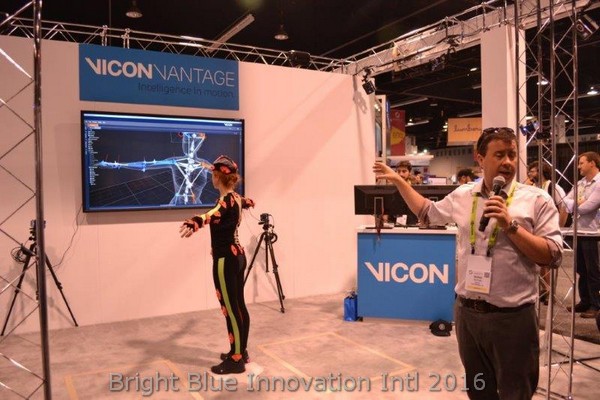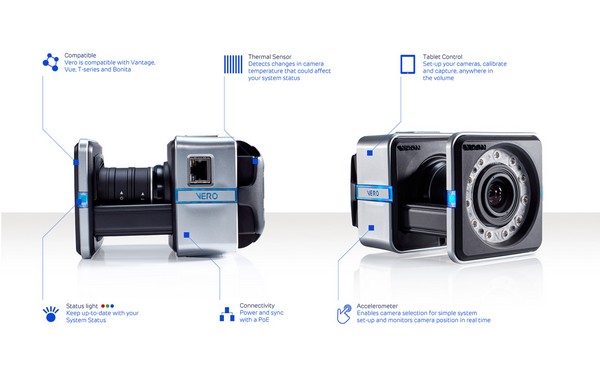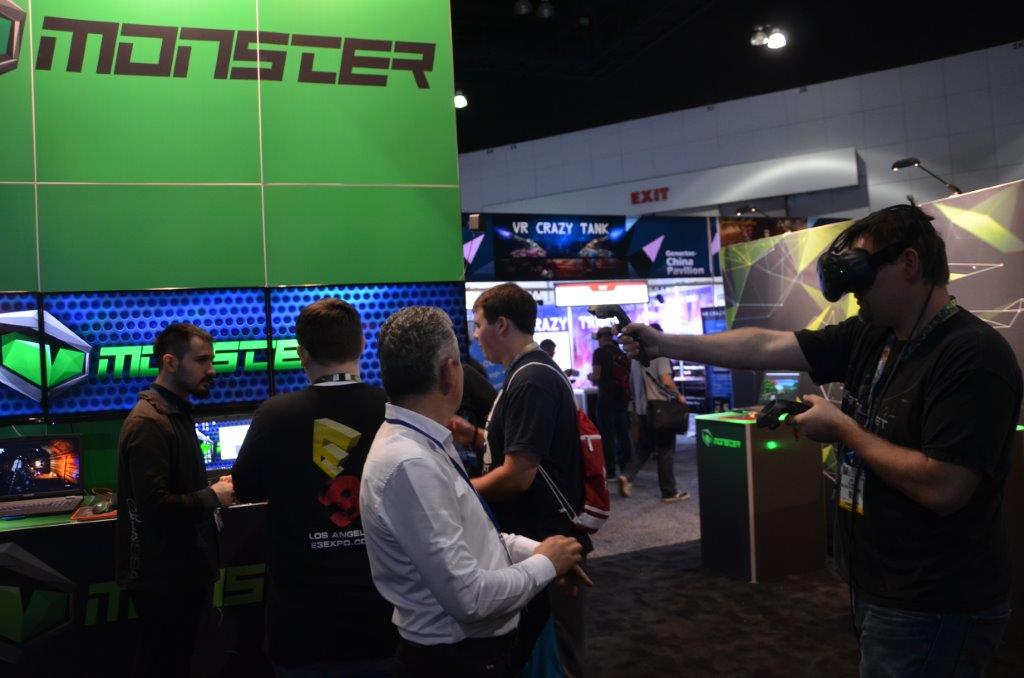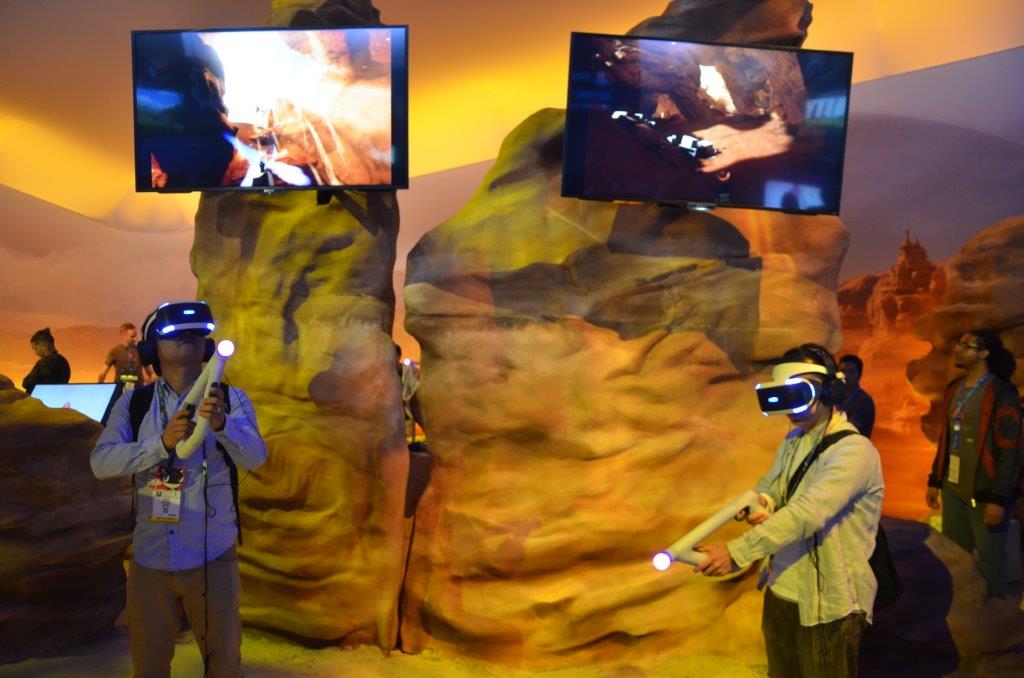
by Lidia Paulinska | Aug 30, 2016
Siggraph, July 2016 – In an interview with Jeffrey Ovadya, Director of Sales and Marketing for Vicon Motion Systems, we got a chance to hear about their latest mocap camera and also Project Katana which was being demonstrated on the conference expo floor at SIGGRAPH 2016.
Motion Capture, or MoCap has moved to the mainstream for VFX production in movies, TV, advertising and most content creation. It has even expanded to support automated PTZ camera movement for live TV production using virtual studios. The primary product from the company is high speed cameras for motion capture that are mounted to a scaffolding system or framing to define a 3D space where the movement is captured. The new cameras and software are designed to be smarter and easier to use, as mocap moves from the professional space to the prosumer market.
For simplicity in the use of mocap, Jeff said that Vicon has started a program called “Project Katana”. The idea behind it is to have a system that in real time will create a mocap skeleton model ad bring the data into systems like Final Cut. The goal is to have final quality, fully rigged and articulated skeletons of the mocap session at the end of each shot. This will provide full skeletons of all characters in the 3D capture space, at the end of each day, along with the production dailies. In order to perform this analysis, the studio setup and network has to be self-healing. The data environment for motion and the rigging connections in the project are being done using a Matlab mathematical modeling core.
The booth at the SIGGRAPH expo was showing the system however there is not release date or a “product name” for when Project Katana will be released.

To address this shift towards simplicity, Vicon has introduced the Vero camera. It is available in two models the v1.3 which is a 1.3MP camera and the v2.2 which is a 2.2MP camera. Designed specifically for mocap applications, the cameras are an 850nm IR greyscale camera that operates at either 250FPS for the v1.3 or 330FPS for v2.2. The high frame rates on the cameras allow for real time and full range live motion capture.
The cameras have a variable focus lens from 6mm-12mm for use in low angle and high angle applications. A major design simplification for the user is the single cable connection. The cameras have standard RJ45/Cat5e Ethernet connector that serves to be the interface for the camera control, data connection from the units and power the units using the POE specification. For this single cable connection system, the cameras have been designed to only require 12W to operate. Like the prior generation and larger camera the Vantage, the Vero has on-board sensors that monitor camera position and temperature to ensure optimal performance.

by Lidia Paulinska | Aug 21, 2016
Siggraph, July 2016 – Due to the complexities of scheduling a large cast of actors and crew it is difficult to move the production to locations around the world. Due to tax rebates and incentives many movies are often shot in just a few locations. What is the solution for a production that is supposed to span the world? That was the situation that was presented to the production of Captain America Civil War which was primarily shot in Atlanta Georgia.
At the Siggraph this year the lead production session was dedicated to “The Making of Marvel’s Captain America: Civil War” movie. Victoria Alonso, Executive Vice President of Physical Production from Marvel Studios, Dan Delleeuw, VFX Supervisor and Swen Gillberg, Associate VFX Supervisor from Marvel Studios, Jean Lapointe, Compositing Supervisor from ILM, and Greg Steele, VFX Supervisor from Method Studios were discussing the production process of the movie.
As we already know the film was primarily shot in Atlanta Georgia and filmmakers utilize VFX to bring locations from around the world to Atlanta digitally. The presenters were detailing the stats for this film. The numbers for the 135 minutes film Captain America: Civil War were as follow: 2,782 finals were created; 2,745 finals were used in the movie, 415 shared shots between multiple VFX teams, 194,608 frames. The production team created description of total 12 characters that play in the movie including: Captain America, Falcon, Scarlet Witch, Winter Soldier, Hawkeye, Ant Man, Iron Man, Black Widow, War Machine, Vision, Black Panther and Spider Man. Every character was evaluated under the criteria such as: Fighting, Agility, Strength, Endurance, Intuition or Psyche. For example the Winter Soldier: Fighting – Incredible, Agility, Strength and Endurance – Remarkable, Intuition – Excellent, Psyche – Typical.
For those who think that the developing story of the film like Captain America is a linear process: Script > Look Development > Story Boards > Previs, they are mistaken. The panelists showed that is more like a matrix of those elements and multiple teams working and a lot of material needed to be shot. Many times short post schedules sometimes required that they started on the assets before the foreground was shot or the sequence was fully realized. They don’t always stick to what was originally planned with pre-vis or story board. As a result a lot additional material was shot to cover all options such as time of day, weather, and any camera angle.
The production of Captain America Civil War was collaborating work of 18 teams worldwide working on a single project.

by Lidia Paulinska | Jul 11, 2016
Pepcom event, June 2016 – There is nothing not to like about Pepcom’s press only events. They are always well organized and have so many innovative products to see. The event happened on the evening of Thursday, May 19th, at the Metreon in San Francisco and focused on mobile products. 21 companies showcased their automotive, mobile and lifestyle innovations at the venue.
Here are take some of the products that I was most excited about:
Moshi, a designer of fashion bags, presented the Helios Lite and Helios backpacks that can carry laptops up to 13”(Helios Lite) and 15” (Helios). Made from ultra-lightweight and durable materials with water-repellent coating that protects in different weather conditions. All Moshi bags are very practical with enough pockets to put your valuables and accessories such as pens, chargers, smartphones and cables, as well as being fashionable for a generation of professionals that lead a busy and demanding lifestyle.

Looking over their other products at the Moshi’s table, I found another nice surprise that was on display. They presented the Avanti; Moshi’s flagship on-ear headphones. This stylish product has good sound and featured a nice ergonomic design. The curved stainless steel headband with soft adjustable ear cups made of soft leatherette lets us solely enjoy the music, which is being isolated from noise and with minimal pressure on the ears. Avanti headphones features high-efficiency 40 mm drivers with high dynamic range.
At the Kingston booth, along with their flagship products, the company division HyperX showcased their latest gaming headset; the HyperX Cloud Revolver, which is now shipping on Amazon, Best Buy and Newegg. The HyperX Cloud Revolver is made with a steel frame suspension design, memory foam and premium leatherette ear cups and headband. It is compatible with PC, console and mobile devices. Their latest version continues to bring high performance products from Kingston Technology using the Cloud.

Escort Inc. and Cobra Electronics, held by Cedar Electronics, showcased an array of dash cams: DriveHD Dash Cams and Drive HD CDR895D, which provide help capture against unexpected accidents on the road. The newest addition, CDR 895D is a dual channel dash cam that simultaneously captures the road ahead and road behind in HD video, offering front view resolution of full 1080P HD and rear view of 720P HD. The CDR 895D will be in Q2 with a MSRP of $229.95.

As we live in the mobile era we can’t forget that every device needs to be charged.
Ventev at its booth offered an array of charging hubs and power solutions. Along with new USB charging hub rq600, there were desktop charging hub s500, USB charging hub 400, global charging hub 300 and wall charging hub 200. On the portable power site, Ventev showcased power cells 10000+, 6000+, 6000c, 6000 and power dash r900. The company is also well known as a producer of cables that are strong, tangle-resistant and optimized.

At the end of my list, I would like to mention TripIt, a mobile application that allow you stress-free travel. The program allows to create a master itinerary for your trips and store your travel plans along with maps and directions in one place. It’s a great addition to your busy lives.

by Lidia Paulinska | Jul 1, 2016
E3, June 2016 – Noel Lee, the founder of Monster Cable, is an entrepreneurial icon in the audio & music industries. He personally designs and tunes every headphones that the company manufactures. Since early 2000s he is active in gaming industry and he presented his products at E3 show this year.
In the new presence at the show, Monster was showing off their high performance wireless products, their high power portable devices, automotive audio and the flagship for the show, their Fatal1ty by Monster gaming headsets. These were announced at CES 2016 and are the joint creation of Monster and video gamer Johnathan “Fatal1ty” Wendel, who set the world standard for competitive video gaming by capturing 12 World Championship e-Sports titles.
Creativity, Innovation and Music Matter is Noel’s favorite statement.
He started his company 37 years ago. Monster Cable & Monster Power was born in Noel’s garage. Today he holds 567 patents and has made milestones in design, comfort & performance. With successes like Beats by Dr. Dre he has now moved beyond the status quo, trailblazing with higher-performance headphones/speakers with Pure Monster Sound that Noel personally designs and tunes himself.
Here is Noel’ story.
In 1968 Noel Lee graduated from Cal Poly, San Louis Obispo and joined Lawrence Livermore National Labs’ engineering team. Six years later he left Lawrence Livermore Labs to go on a world tour with his band, Asian Wood. But he did not quit his engineering talents to create a better way to listen to music than through a zip cord. On June 26th, 1978 he registered his new company name “Monster Cable” and began production in his garage in San Francisco. Year later Lee created the first Monster cable and showcased it during summer CES in Chicago. In 1980 his company moved out of the garage to first office 101 Townsend Street in San Francisco. Lee hired his first employees, Tai Min and Shang Yu Chang, who are still with the company today. In 1998 the company moved again to the new headquarters in Brisbane, California.
Of the 567 patents that Noel holds, the first U.S. patent was for the Xterminator electrical connector (1983). He introduced to the market many products: The MacSpeaker, the first computer speaker (1985), Music Logo (1986), Monster XP, the first new high-performance cable since the original Monster cable was born (1991), M Series, with the introduction of a new line of high-end speaker cable (1992). There were also many awards such as three innovation awards for Monsterous product in 2001.
In 2008 he was awarded with the title of “Enterpreneur of the Year” by Ernst & Young after he introduced Monster Game, a new product line for PS2, XBOX and Gamecube. In 2009 he launched Monster iSport headphones and made his appearance in gaming industry. The Fatality headset is his newest premium product that targeting the gaming space, and it was the basis of Monster’s first appearance at the E3 expo. Monster has held a long tradition of having a major presence in consumer, professional and technical trade events and expos, and now the gaming industry has them in their fold.

by Lidia Paulinska | Jun 27, 2016
E3, June 2016 – It is a season for Virtual Reality. At E3, the gaming world show that took place in June at the Convention Center in Los Angeles, the VR was presented everywhere. So far, virtual reality is associated with gaming industry sector mostly because the hard-core gaming community is willing to spend large amount of money for special purpose hardware such as VR glasses and games consoles.
VR hardware was the big draw this year. The major platforms that were at the show took the spotlight since there was no major console release. Dominating the major exhibits were the Sony Playstation VR units, Occulus, and Samsung Gear. Dominating the software showcases was dominated by the HTC Vive. Not counting the companies in the private rooms for demos, there were16 companies on the two expo floors with VR hardware or software. These included: Sony, Occulus, Samsung, HTC, Pop up Gaming, Time of VR, Naughty America, CAPCOM, Carl Zeiss, Alienware, Bethesda, Warner Bros, Ubisoft, Cubicle Ninjas, Razer and Nyko.
The computer-simulated reality dates back 77 years. Here are the key moments in VR history. It started in 1939 at the trade show in New York City where introduced View-Master, a stereoscopic alternative to panoramic postcard. After that 30 years passed while Ivan Sutherland came up with first head-mounted display called “The Sword of Diamocles”. It passed another 30 years when the computer games company Sega introduced wrap-around VR glasses at CES in 1993. Two years later Nintendo produced the gaming console and named it Virtual Boy.
The real gold rush for virtual reality started in 2010. The market research analysts from Deloitte, CCS Insight, Barclays and Digi-Capital accordingly forecast that $24 million of VR devices will be sold by 2018, and revenue from virtual and augmented reality products and content will reach to the $150 billion mark by 2020.







